VIRTUAL REALITY: THE NEXT HEALTHCARE EXPERIENTIAL FRONTIER
A summary of the second (Tech)eTuesday
By Gloria Zaionz (Advanced Technologies team at Kaiser Permanente and Emerging Technologies lead at the Innovation Learning Network)
We hear about VR everywhere and its potential to change the way we interact. But until recently, virtual reality experiences required expensive and bulky equipment set up and was often used for simulation training or for experienced-based entertainment.
With the entrant of consumer grade VR goggles – Hololens, HTC vive, Samsung Gear and even Google Cardboard, VR has hit a new wave of adoption and health care is starting to realize the opportunity VR offers in patient care.
The Innovation Learning Network, in collaboration with the Global Network of Healthcare Innovation Centers (GNHIC), joined together to explore virtual reality in health care in an ILN Teche Tuesday: Virtual Reality: The Next Health Care Experiential Frontier.
The session featured 4 industry experts:
- Megan Moyer of Sutter Health to introduce virtual reality, its history, current and future roadmap;
- Brennan Spiegel, M.D. of Cedars-Sinai, a well known health care VR maverick to set context on how health care benefits from the use of VR in patient setting;
- Andy Cundiff of Carolina’s Healthcare System to highlight use cases the health system is exploring today; and
- Fred Galstaun of Sensiks, an immersive pod featuring audio-visual experiences synchronized with scents,temperature, airflow, vibrations and light frequencies.
Introduction
A history of Virtual Reality: a fly through with Megan Moyer
@MeganWMoyer
AR/VR/MR: What is it and how do they differ?
Virtual Reality (VR): In VR, a person from the real world is immersed in a digital world fully , typically wearing a head mounted display and immersed in a digitally created content like CGI and video games or analogue content like a 360-degree spherical video shot around so you feel like you’re in a new location, more of a passive consumption of the content instead of the interactive video game.
Augmented or “Mixed” Reality (AR/MR): AR / MR refers to digital content is overlaid on top of the ‘real world’ in front of you. Because it is an overlaid image, multiple people can share in the same viewing experience. Microsoft HoloLens is the most well know device on the market today.
History of VR
Since the 1700’s, people have tried to create the ability to transpose oneself into another place. This began with panorama art in 1792 followed by cycloramas where people can go into a building to ‘experience’ art created. In the 1950s, the advent of cinematic projection added motion, which deepened the immersive experience. The best example is the Disney CircleVision. Today we have iMax and Planetariums – all created to give us a sense of being in a new place.
Gadgets from the Holmes Stereoscope in 1861 to the 1980s Viewmaster also play an important role. In fact, VR spaces and headsets in arcades and gaming existed since the 1980s. It was difficult to find new use cases outside of gaming due to high cost and high level of difficulty to create quality content to make the experience truly immersive.
Finally! Commercial success! 2016 / 2017
In this past year, VR has made a significant breakthrough into the consumer market with the introduction of the cheap Google Cardboard to the Sony Playstation VR. The options on the market today range in price and capability: The options on the left use the phone as the processor and the images can be pixelated while the systems on the right plug into a gaming console or PC which really makes one feel immersed in another world.
Best uses for VR: Emotion vs. Practical Benefit
Emotional Benefit
Entertainment: Gaming is the biggest application of VR. You can be anyone you want to be: an avatar, another character in another world. You can even share viewing experiences with others.
Escape: You can experience the sensation of a new place and experience. VR lets users feeling like you’re somewhere else, especially if you feel isolated or lack mobility (like in a hospital).
Creativity & Expression: VR is changing creativity and expression from hearing to experiencing. For example, Google Tilt Brush lets users make 3D art and the DogHouse VR Installation featuring an awkward family with each of the 5 VR headsets mapped to a different character in the play.
Empathy: Walk a mile in someone else’s shoes. Journalism, news, and philanthropy are exploring ways to create empathy by showing instead of telling.
Practical Benefit
Building: Trying out concepts before building in real life. Can have significant financial benefit by not having to build prototypes of expensive items.
Shopping / retail experiences: Virtual malls and virtual grocery stores so consumers can feel like they are in a grocery store making purchases.
Training: Most widespread uses of VR is training and education. The military has been using this training platform for years. In addition, VR can be used for occupational safety and hazard training by letting users train in a safe, effective, and low cost environment.
Healing: Health care is looking at pain relief using VR. Studies have shown using VR lowers pain more than opioids.
 Courtesy: Megan Moyer
Courtesy: Megan Moyer
Where is it going? And what is needed to get there?
- Multiple layers of sensory engagement.
VR in its current form relies on visual and auditory immersion. To be fully immersed, VR must engage other sensory organs including the use of haptic suits to create sensory engagement in the body: vibrations to emulate bumping into walls or getting hit by something; contraptions to emulate motion – wind on the face as if you’re flying. In the near future, there will be layers of sensory immersion added beyond eyes and ears. - Untethered
Untethering from wires with freedom to move around the room where one is physically mapped to a digital world. Untethering lets users feel like they are partaking in the digital world even though they are moving in the physical world. - Fluid Interactions.
Users need to feel fully integrated into the digital environment. Being able to use natural interaction modality such as touch or grasp without delay is important. - Connection
VR in its current form is frequently a single-user interaction. As human beings, we are social and VR needs to evolve to a social platform where users connect with others. There is a race to create the most engaging social platform with Second Life having been around for years. It is a platform where users can generate their own content. Altspace VR is another large platform. One exciting development is the ability of inserting ‘ourselves’ or our likeness into the 3D world using 3D volumetric camera where one can create an interactive ‘self’.
Immersive VR is the next frontier
What does the future hold? Fully immersive VR experience inside a digitally rendered immersive room where one can enter to experience a new world, without being isolated.
Healthcare Perspective
Lessons Learned Using VR for Patient Care with Brennan Spiegel, M.D., MSHS
@BrennanSpiegel
Cedars-Sinai, under the leadership of Dr. Brennen Spiegel, has, to date, exposed over 500 patients using VR as therapeutic intervention for a wide variety of use cases. Pain management is the primary focus and a secondary focus on managing chronic diseases such as high blood pressure management.
How this got started: Understanding the Patient Experience in a Hospital Room
In even the nicest hospital rooms, it is not a place of rest nor place of healing for patients who are spending time there. This is a place where patients can suffer grievously, physically, emotionally, socially, and feel socially isolated, stigmatized by their illness. It is not a place one wants to come.
Below is the patient’s ‘view’ if they’re bed bound and cannot walking around. Most of the time, it’s the white ceiling with 4 white walls. And from time to time, someone walks by and looks at them, most likely without a smile. This is essentially the ebb and flow of a patient’s day.
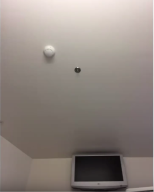
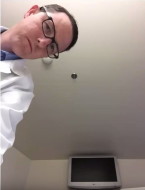
Courtesy: Brennan Spiegel
How VR became a solution: The Why
As the team began to explore ways to change the patient experience about 3 years ago, they thought of VR as an opportunity for patients to get away from their biosocial-jail cell (aka hospital rooms) and send them to fantastical destinations like flying a helicopter or sitting on a beach.
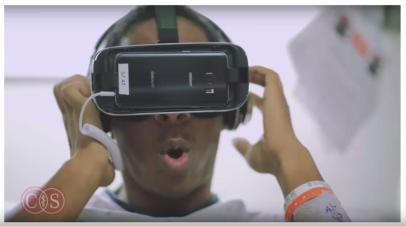
Patient experiencing VR for the first time. Courtesy: Brennan Spiegel
Brennan and his team began to introduce VR to patients and studied the impact and outcome of these digital interactions. One set of content available is the Anxiety Reliever created by AppliedVR, a company specializing in therapeutic VR, where a patient can meditate at the ocean while listening to a voice-over script with a mindful meditation dialogue.
To see patients’ reaction, visit www.virtualmedicine.org for a collection of videos.
Research Study: Efficacy of VR in Pain Management
To evaluate the impact VR has in pain management, the team at Cedars-Sinai conducted a research study of 50 patients. The study’s objective is to evaluate VR’s impact on pain by comparing pain levels before and after 1 time VR treatment. The results were then compared to a control group that watched 2D relaxation clips on a TV screen.
While both showed decrease in pain, there was a significant difference favoring VR.
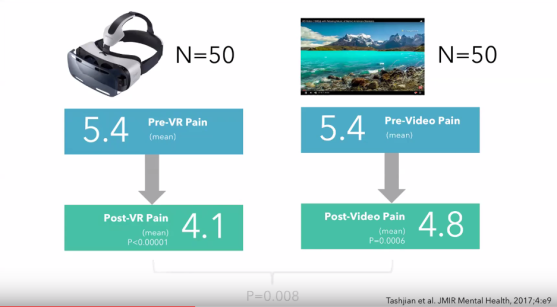
Courtesy: Brennan Spiegel
When the team looked at the results from a clinically important response approach, they found a 65% response in the VR group compared with 40% response in the control group, a difference of 25%. In this study, the NNT (number needed to treat) is 4. The NNT for opioids is between 4 and 7 depending on which study you look at. So what this means is for every 4 people using VR, instead of a controlled condition, there is 1 additional person who had clinically significant benefit.

Courtesy: Brennan Spiegel
The team just completed another study that is the largest randomized controlled trial of VR, where VR is used throughout the hospital stay. The results, again, favored virtual reality and will be published soon.
A review of other VR studies show that VR is an effective solution, even with some unintended side effects such as vertigo, which is typically caused by latency.
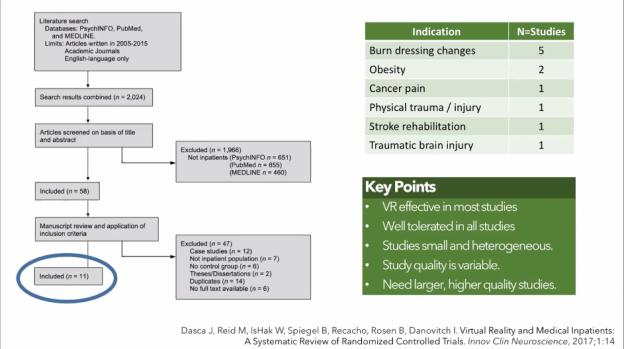 Courtesy: Brennan Spiegel
Courtesy: Brennan Spiegel
Another Use of VR
A sense of normalcy for patients.
One project underway involves sending people home with a Samsung 3D camera so they can record the home environment and daily activities. The image is then loaded for hospital-bound patients so they can be at ‘home’ with their family.
The team is working with the Yellowbird Labs (in Netherlands) to leverage its livestream technology for wider patient population and for pediatric patients.
Health education and chronic condition intervention.
The Cedars-Sinai team, in collaboration with the Holman United Methodist Church, created a tailored VR program to inform and educate the local community about hypertension and high blood pressure management. The program is set in a kitchen and shows where salt lives in the diet and ways to reduce salt consumption.
The pilot study just finished with results showing significant reduction in blood pressure with the bi-modal intervention approach that incorporates behavioral intervention. Program participants’ systolic pressure dropped by 7 points over the 12 week course of treatment.
Key Takeaway & Lessons Learned: VR as a prescription
If VR is a therapy, then we need a “VR Pharmacy” where shelves of evidence-based VR content is available for physicians to map to individual patients based on psycho-metric profiles and medical profiles, and sociodemographic profiles. VR is the delivery format or the “syringe”. It’s the content that is most important. The team is now working on software to profile patients and match the VR content
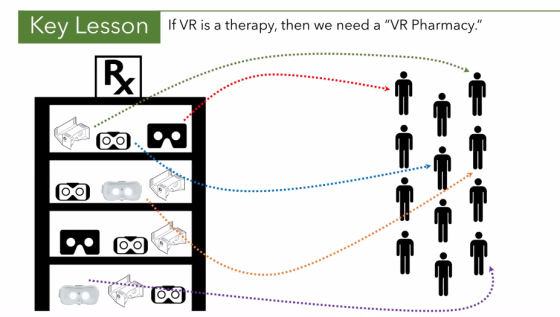
Courtesy: Brennan Spiegel
“VR takes a village. This work takes tremendous amount of people to implement and support.”
Unexpected Outcome: Blueprint of Future VR Medical Research
As part of sharing its VR journey with the world, Dr. Spiegel’s team found significant insights and consumer sentiments tucked away in the comments section of its online video library. This led to a study of consumer sentiment that found insights on:
- Positive and negative concerns of VR
- Use cases
- Users of FB had tremendous insights into concerns, benefits, and use cases far beyond what could ever be imagined
This is now being used as a blueprint of where medical VR research needs to go next. The study results will be presented soon in full detail.
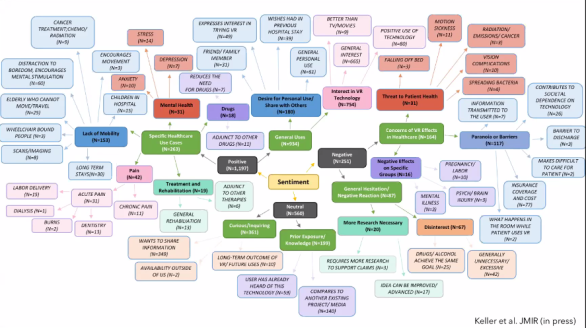
Courtesy: Brennan Spiegel
Health Care Use Cases
Deep dive into use cases at the Carolinas Healthcare System with Andy Cundiff
@IAmCundiff
In the past 2 years, the Charlotte AHEC has been using AR, VR, and 360 degree video as a means of delivering education to medical students. The Charlotte AHEC (Area Health Education Center) is charged with providing continuing medical education for Charlotte area clinicians.
Use case #1: Patient safety – 5 scenarios of retrieval of foreign object
Technology Deployed: 360-degree video
The objective of the tool is to educate users about common mistakes that happen in an OR suite. Users are able to view from multiple angles with a view of the entire OR and can observe a video clip containing 5 scenarios with the ‘correct’ and ‘incorrect’ actions.
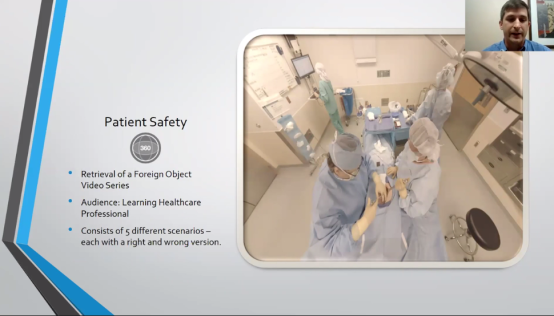
Courtesy: Andrew Cundiff
Use Case #2: Carolinas Simulation Center – Virtual Tour
Technology Deployed: 360-degree video
The tour lets visitors of the Carolinas Simulation Center familiarize self with the space prior to a visit. Users can click on the blue markers for additional info about each object and how to use the technologies. While fully immersive VR would be a great way to go, it is not feasible to get everyone a headset due to cost.

Courtesy: Andrew Cundiff
Use Case #3: AR for patient education
Technology Deployed: AR
An AR application is deployed in the urology department to show specific kidney disease state to inpatients. The objective of the study is to improve patient education by telling them what’s going on with them in a manner that is more visually relevant than a hand drawn image. The research is under way.
Use Case #4: VR for Nurse Burnout
Technology to Deploy: VR
An approved IRB study in the participant recruitment stage. The objective of the study is to test VR as a tool to improve mood and reduce anxiety with an outcome of better patient care.
Use Case #5: VR for Alternate Focus (distraction)
Technology Deployed: VR
Exploring opportunities to divert patient attention away from their current state of well-being.
Featured Innovator
Sensiks: Sensory Reality Pod with Fred Galstaun
http://www.sensiks.com/
The design journey of Sensiks began in 2011 when Fred Galstaun, Founder of Sensiks, experienced burnout. When Fred found himself finally able to relax while laying on a beach, he wanted to recreate the experience – leading to deep research about immersion and experience and what it takes to replicate an experience that is truly immersive.
What is real?
To understand what it would take to recreate the experience, Fred delve into the ageless question “What is real?” For something to be ‘real’ one must be able to: talk about it, feel it, smell it, taste and see it. However, it really boils down to a series of electrical signals interpreted by the brain.
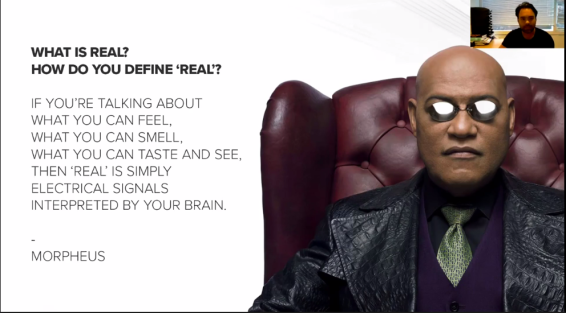
Courtesy: Fred Galstaun
As Fred pushed onto understand these ‘electric signals’, he soon learned that our reality is comprised of different types of waves: heartbeat, breath, movement. All these waves are in essence a fluctuation of energy: plus and minus or zeros and ones.
The human brain interprets said input and processes it leading to “experiencing”. Process of experience directly results from sensory activation. This lead to the concept of Sensory Reality.
Sensory Reality
Sensory reality refers to the more parts of the brain that are activated by the different types of sensory stimulation, the more deeply the experience, in turn, a deeper emotional impact. Most experiential engagement today only activates 2 sensory parts. The moment more sensory modals are engaged, the brain switches from observing to experiencing.
How do we create sensory reality?
To create sensory reality, one must create a fully interactive sensory environment with 360-degree surrounding. The Sensiks pod measures sensory output and responses to the stimuli to determine emotional response.
Current Applications & Use cases:
Sensory cure & care: for patients with Alzheimer’s disease.
Sensory psychotherapy: relive a trauma, such as PTSD, in order to work through it.
Improve quality of life: One example is Sensiks’ work with Philadelphia’s (The Netherlands) mentally disabled individuals to improve quality of life.
Source: https://radboudreshapecenter.com/blog/virtual-reality-the-next-healthcare-experiential-frontier/


